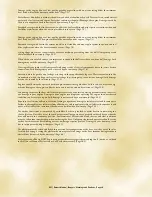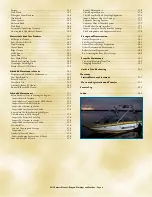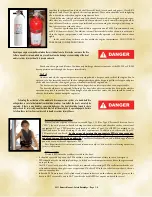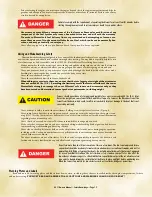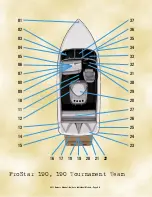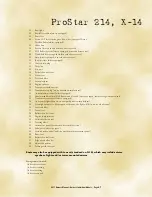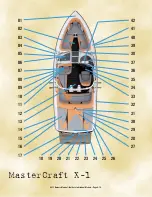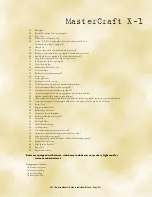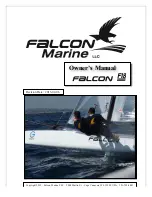
Anchoring
Anchoring is done for two principal reasons: first, to stop for fishing,
swimming, lunch or an overnight stay, and secondly, to keep a boat from
running aground in bad weather or as a result of engine failure.
When preparing to anchor, bring the bow of the vessel into the
wind or current. Place the engine in neutral. When the boat comes
to a stop, slowly lower the anchor. Do not throw the anchor over as
it will tend to foul the anchor or tangle line. When the anchor line
has been let out, back down on the anchor with the engine in idle
reverse to help set the anchor. After it is firmly set, use reference
points (landmarks) in relation to the boat to be sure that the boat is
not drifting. Check the points frequently.
Communications
The following applies to salt water boating:
When boating off-shore, carry communications gear such as a marine
VHF-FM and/or HF transceiver(s), appropriate to the operating area.
Cellular phone coverage is available in many coastal areas. However, cel-
lular phones should NOT be considered a substitute for VHF-FM marine
band radios for emergency purposes.
Satellite EPIRBs (406 MHz) are designed to quickly and reliably alert
rescue forces, indicate an accurate distress position, and guide rescue
units to the distress scene, even when all other communications fail.
When activated, the satellite EPIRB transmits a distress signal with
a beacon-unique identifying code. The system detects the signal, calculates an accurate distress position,
checks the unique identifying code against the EPIRB registration database (vessel and point of contact infor-
mation supplied by the owner) and routes the distress alert with registration information to the responsible
U.S. Coast Guard (or International) Rescue Coordination Center (RCC). 406MHz EPIRBs with GPS (internal
or attached) also provide an immediate GPS position in the information passed to the RCC.
Geostationary satellites make detection almost immediate. If the EPIRB does not have the ability to
provide a GPS position, the process to determine a position takes about an hour on average and almost
always less than two hours. Satellite EPIRBs also include a homing beacon and strobe to help rescue forces
quickly locate the distress scene.
Satellite beacons have significant coverage, alerting timeliness, position accuracy, and signaling ad-
vantages over other types of EPIRBs (121.5 MHz). Before purchasing or using something other than the
406 MHz EPIRB, be sure to understand the capabilities and limitations.
In distress situations, press the transmit button and clearly say: MAYDAY, MAYDAY, MAYDAY. Follow this
with the vessel name and/or description, the location, nature of emergency and number of people on-board.
Then release the transmit button and wait for 10 seconds. If there is no response, repeat the MAYDAY call.
Further information and a complete listing of VHF channels and frequencies is available at: www.
navcen.uscg.gov.
Law Enforcement
A vessel underway, when hailed by a Coast Guard vessel is required to heave to, or maneuver in such a
manner that permits a boarding officer to come aboard.
Other federal, state and local law enforcement officials may board and examine a vessel. The Coast Guard
may impose a civil penalty up to $1,000 for failure to comply with equipment requirements; report a boating
accident; or comply with other federal regulations. Failure to comply with the Inland Navigation Rules Act of
1980 can result in a civil penalty up to $5,000. Details of the Act are available online or through the U.S. Coast
Guard and the Coast Guard Auxiliary.
Improper use of a radio-telephone is a criminal offense. The use of obscene, indecent or profane language
during radio communications is punishable by a $10,000 fine, imprisonment for two years or both. Other pen-
alties exist for misuse of a radio, such as improper use of Channel 16 VHF-FM. Channel 16 is a calling and dis-
tress channel. It is not to be used for conversation or radio checks. Such communications should be conducted
on an authorized channel.
Note that there are stringent requirements regarding, pollution, discharge of oil, discharge of garbage
and the operation and discharge from sanitation devices. It is the boat owner’s and operator’s responsibility
to determine what the laws and regulations are and to ensure that those laws and regulations are respected
and enforced.
Details are available through the Coast Guard.
2011 Owners Manual...Safety Knowledge...Page 1-10
Содержание prostar 190 2011
Страница 26: ...Guide to Individual Models 2011 Owners Manual Guide to Individual Models Page 4 1...
Страница 81: ......
Страница 93: ......
Страница 105: ......


